What a difference 600 feet makes. In my back yard, the Goldenrod (Solidago spp.) is just breaking into bloom. Less than 25 miles west-southwest and a little more than 600 feet higher in the mountains, it is already passing its prime.
There are more than two dozen Goldenrod species native to Pennsylvania, told apart in many cases by very technical and subjective considerations. They are very difficult to identify to species; I don’t try.
That said, Goldenrod flowers are terrific places to look for insects that graze on their nectar. One of the most common is Pennsylvania’s very own Goldenrod Soldier Beetle (Chauliognathus pensylvanicus).

Look closely at the right elytra (that’s the hard wing covering of a beetle—pretty much what makes a beetle a beetle). See it?
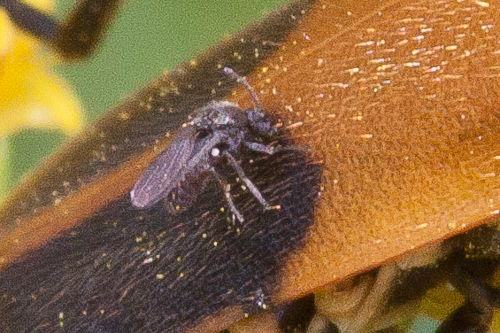
I have no idea what it is. It looks like some kind of gnat—that’s all I’ve got folks.
Locust Borers (Megacyllene robiniae) roam among the florets.

Although these are astonishingly beautiful little critters, they are very destructive of their host, Black Locust (Robinia pseudoacacia). 1
As the locust trees have been spread from the southern Appalachians pretty much throughout the country, the Locust Borers have spread with them.
Goldenrod also draws an abundance of bees and wasps.
Blue-winged Wasps (Scolia dubia) are among the easiest to identify. These are “good guys,” having diversified from their native prey to include Japanese Beetles. Good on ‘em.
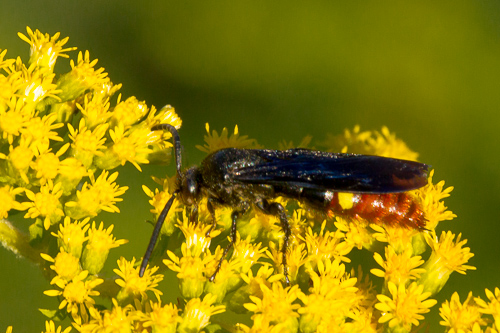
Blue-winged Wasps can often be found on the same flower as the closely related Double-banded Scoliid (Scolia bicincta).
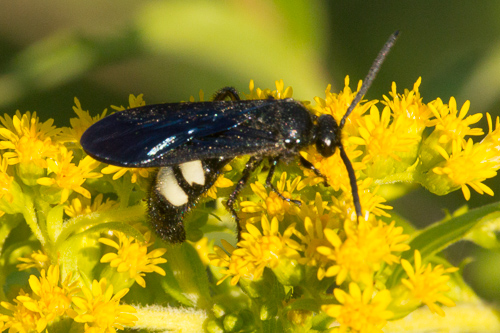
So, this must be a third Scolia—
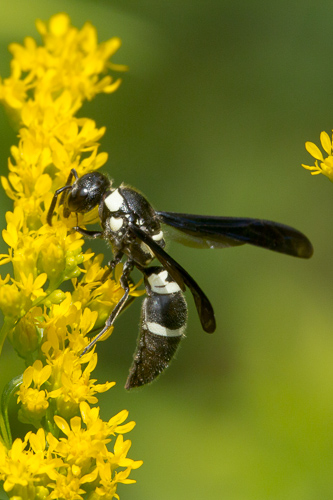
Nope, wrong genus. 2 This appears to be Pseudodynerus quadrisectus the poor fellow doesn’t seem to have a common name beyond “Potter Wasp,” which applies to a whole bunch of different wasps, I believe.
Of course, wherever you find grazers, you find their predators as well. If you notice a peculiarly quiet bee, look again.
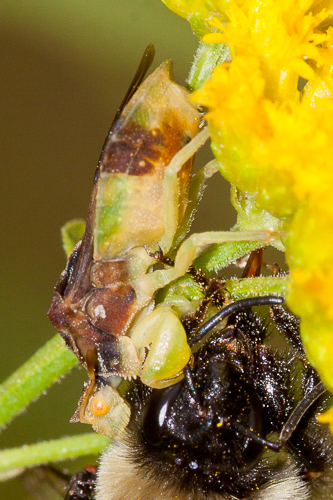
This hapless bumblebee (Bombus spp.) has been double-teamed by Jagged Ambush Bugs (Phymata spp. –I think it is P. pennsylvanica). I seldom find a Goldenrod patch in full bloom without finding a couple dozen of these little nightmares.
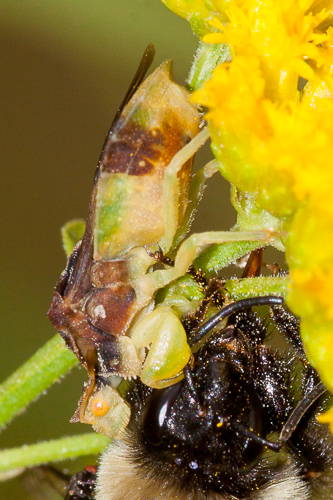
You didn’t really need to sleep tonight, didja?
There is a common motif with these late summer feeders—many are marked with protective coloration, in particular, something like International Orange, the color of traffic cones, hunter orange, and the stripe on the bow of U.S. Coast Guard (Semper paratus) vessels. It is the reason that the Golden Gate Bridge is golden. 3

As an attention getter and a warning, orange must be fairly effective. 4
We have a variety of orange-blazoned moths, like this Black-and-yellow Lichen Moth (Lycomorpha pholus), one of many browsing among the blossoms.
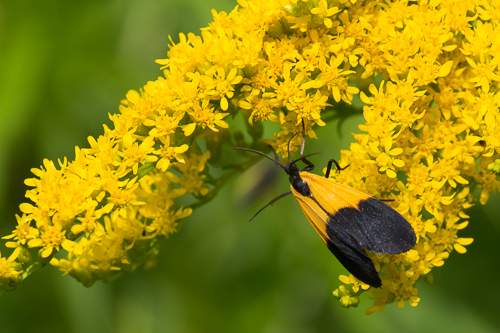
There are also beetles, although this one just sort of blundered into the Goldenrod and then fell down into the grass; it is a Net-wing Beetle (genus Calopteron, possibly the End Band Net-wing C. terminale).
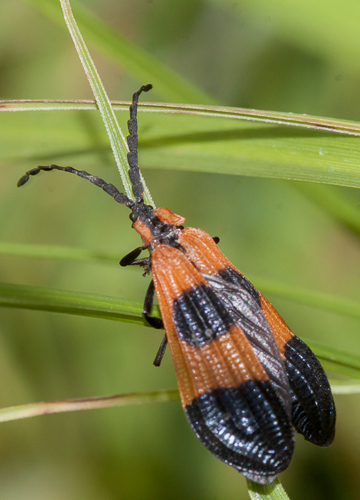
The Ailanthus Webworm Moth (Atteva aurea), also has warning colors.
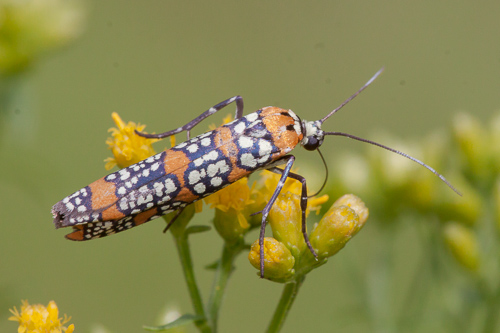
This is an interesting creature:
“The main larval food plant (Ailanthus altissima)…occurs throughout most of United States and southern Canada, often planted as an ornamental in urban areas. The tree is native to Asia, and is an invasive species in North America, but the moth is native, and its range has increased, presumably, since the introduction of the tree.” 5
So, what did it eat before the invasion of the Ailanthus?
- For those who grew up south of the Mason Dixon Line, the fact that something is destructive of Black Locust doesn’t tend to even move the needle on our “so-what” gauges. It is a messy tree covered with nasty thorns that was only used for fence posts and firewood. It is very tough on tools. However, I now read that there is an effort to use Black Locust in lieu of rainforest hardwoods—or at least that is what the good folks at Black Locust Lumber say: http://www.blacklocustlumber.com/the_tree.htm
- Wrong family, even the wrong superfamily, as well. Same order though: Hymenoptera, the Ants, Bees, Wasps, and Sawflies. The Scolia wasps are, well, Scoliidae, the only family in the Superfamily Scoliodea. Pseudodynerus quadrisectus is more closely related to Yellowjackets etc.: Vespidae, which is one of two families in the Superfamily Vespoidea. Glad we cleared that up.
- It was also the color of the U.S. Army’s primary training helicopter, the TH-55 Osage, which, we were told was painted that color so the wreckage would be easier to find after we crashed. That passed for humor at the time. Actually there isn’t one International Orange. It varies, but you get the idea.
- We have family members serving in the Coast Guard, hence the obscure reference. We are–not so quietly–proud.
- BugGuide, Species Atteva aurea – Ailanthus Webworm Moth – Hodges#2401, Info tab: http://bugguide.net/node/view/430 [accessed 22 August 2013].
